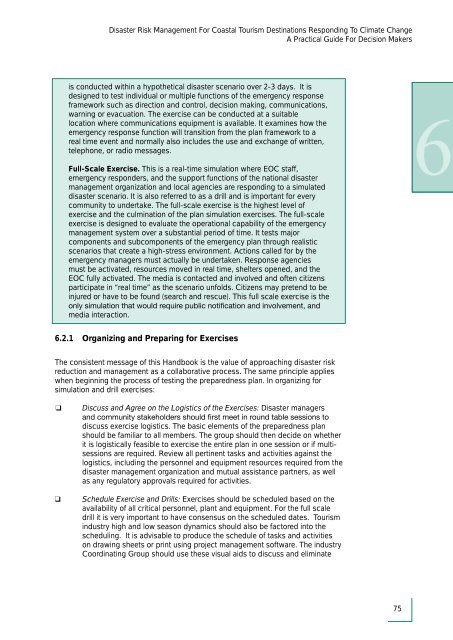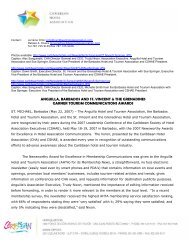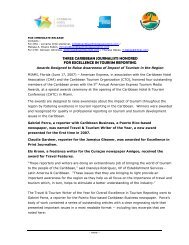Disaster Risk Management for Coastal Tourism - Caribbean Hotel ...
Disaster Risk Management for Coastal Tourism - Caribbean Hotel ...
Disaster Risk Management for Coastal Tourism - Caribbean Hotel ...
You also want an ePaper? Increase the reach of your titles
YUMPU automatically turns print PDFs into web optimized ePapers that Google loves.
<strong>Disaster</strong> <strong>Risk</strong> <strong>Management</strong> For <strong>Coastal</strong> <strong>Tourism</strong> Destinations Responding To Climate Change<br />
A Practical Guide For Decision Makers<br />
is conducted within a hypothetical disaster scenario over 2-3 days. It is<br />
designed to test individual or multiple functions of the emergency response<br />
framework such as direction and control, decision making, communications,<br />
warning or evacuation. The exercise can be conducted at a suitable<br />
location where communications equipment is available. It examines how the<br />
emergency response function will transition from the plan framework to a<br />
real time event and normally also includes the use and exchange of written,<br />
telephone, or radio messages.<br />
Full-Scale Exercise. This is a real-time simulation where EOC staff,<br />
emergency responders, and the support functions of the national disaster<br />
management organization and local agencies are responding to a simulated<br />
disaster scenario. It is also referred to as a drill and is important <strong>for</strong> every<br />
community to undertake. The full-scale exercise is the highest level of<br />
exercise and the culmination of the plan simulation exercises. The full-scale<br />
exercise is designed to evaluate the operational capability of the emergency<br />
management system over a substantial period of time. It tests major<br />
components and subcomponents of the emergency plan through realistic<br />
scenarios that create a high-stress environment. Actions called <strong>for</strong> by the<br />
emergency managers must actually be undertaken. Response agencies<br />
must be activated, resources moved in real time, shelters opened, and the<br />
EOC fully activated. The media is contacted and involved and often citizens<br />
participate in “real time” as the scenario unfolds. Citizens may pretend to be<br />
injured or have to be found (search and rescue). This full scale exercise is the<br />
<br />
media interaction.<br />
6<br />
6.2.1<br />
Organizing and Preparing <strong>for</strong> Exercises<br />
The consistent message of this Handbook is the value of approaching disaster risk<br />
reduction and management as a collaborative process. The same principle applies<br />
when beginning the process of testing the preparedness plan. In organizing <strong>for</strong><br />
simulation and drill exercises:<br />
<br />
<br />
Discuss and Agree on the Logistics of the Exercises: <strong>Disaster</strong> managers<br />
<br />
discuss exercise logistics. The basic elements of the preparedness plan<br />
should be familiar to all members. The group should then decide on whether<br />
it is logistically feasible to exercise the entire plan in one session or if multisessions<br />
are required. Review all pertinent tasks and activities against the<br />
logistics, including the personnel and equipment resources required from the<br />
disaster management organization and mutual assistance partners, as well<br />
as any regulatory approvals required <strong>for</strong> activities.<br />
Schedule Exercise and Drills: Exercises should be scheduled based on the<br />
availability of all critical personnel, plant and equipment. For the full scale<br />
drill it is very important to have consensus on the scheduled dates. <strong>Tourism</strong><br />
industry high and low season dynamics should also be factored into the<br />
scheduling. It is advisable to produce the schedule of tasks and activities<br />
on drawing sheets or print using project management software. The industry<br />
Coordinating Group should use these visual aids to discuss and eliminate<br />
75








